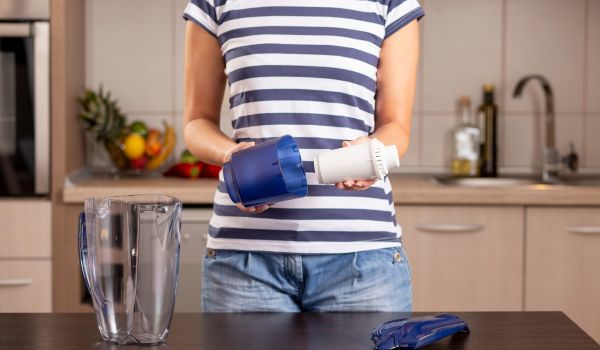A water filter pitcher is one of the easiest ways to boost the quality of your tap water — but only if you keep it clean.
Without regular maintenance, even the best pitchers can develop mold, mineral buildup, or funky odors that undo all that filtering work.
Whether you use Brita, PUR, or another brand, keeping your pitcher fresh is quick, easy, and totally worth it. 🧽
Let’s walk through exactly how to clean your water filter pitcher — and a few smart habits to keep it working like new. 💧
🧠 Quick Takeaways
- ✅ Regular cleaning keeps your pitcher free from mold, minerals, and funky odors.
- ✅ Brita pitchers (and most brands) should always be handwashed — never in the dishwasher.
- ✅ Give your pitcher a gentle clean every 2–4 weeks, or whenever you change the filter.
- ✅ A vinegar rinse now and then helps prevent hard water buildup.
- ✅ Staying consistent with cleaning = longer pitcher life and better-tasting water. 💧
If it’s time for a new — see our top rated filter pitchers.
🧼 Can You Put a Brita Pitcher in the Dishwasher?

Short answer? Nope. 🛑
Brita pitchers (and most water filter pitchers) are not dishwasher-safe. Even if some parts feel tough, the high heat in a dishwasher can warp the plastic — messing up the lid seal, the reservoir fit, and eventually the filtration performance.
That tiny warping can turn into a big problem over time — letting dust, bacteria, and even mold sneak into your drinking water.
- ✅ Best Practice: Always handwash your pitcher gently with warm, soapy water.
- ✅ Pro Tip: Use a soft sponge — never anything abrasive — to keep it looking like new.
💬 Good to Know: Some brands do claim their pitchers are dishwasher-safe, but even then, it’s safer to skip the heat and handwash. Your filter (and your taste buds) will thank you!
🧽 How Often Should You Clean Your Water Filter Pitcher?

Keeping your pitcher clean is just as important as changing the filter. 🧼
- ✅ Every 2–3 weeks — give your pitcher a full cleaning, inside and out.
- ✅ Every filter change — always clean the pitcher when you install a new filter.
- ✅ After any odd smell, taste, or buildup — even if it’s earlier than scheduled.
Skipping cleanings can lead to mold, bacteria growth, or just plain funky water. Not exactly what you want in a pitcher designed for better drinking water, right?
💬 Good to Know: Some brands have slightly different cleaning timelines, so it’s smart to double-check your pitcher’s manual if you’re unsure. (Brita recommends cleaning every few weeks — and we agree.)
🦠 Why Cleaning Your Water Filter Pitcher Really Matters

Sure, your pitcher might look clean — but it’s what you can’t see that can cause problems. Here’s why regular cleaning is non-negotiable:
- ✅ Stops Mold and Mildew Growth: Pitchers are a damp, enclosed space — prime real estate for mold if you skip cleanings.
- ✅ Keeps Bacteria in Check: Even filtered water can pick up bacteria from your hands, fridge, or kitchen surfaces. A quick clean keeps germs from multiplying.
- ✅ Prevents Mineral Buildup: Hard water minerals (like calcium and magnesium) can leave a white, gritty residue inside your pitcher over time. Regular scrubbing keeps it crystal clear.
- ✅ Protects Filter Performance: Gunk and grime buildup inside the reservoir can interfere with water flow and clog your filter faster.
- ✅ Preserves Taste and Freshness: Nothing ruins a crisp glass of water faster than stale, funky flavors caused by a dirty reservoir or lid.
💬 Good to Know: Even “clean” tap water can introduce unseen debris into your pitcher over time — keeping it washed and sanitized is part of protecting your drinking water.
🧽 How to Clean a Water Filter Pitcher (Step-by-Step)

Keeping your pitcher spotless doesn’t have to be complicated. Follow these simple steps to make sure every glass stays crisp, clean, and contaminant-free:
| Step | What To Do |
|---|---|
| 🧩 Disassemble | Remove lid, reservoir, and filter for full access to all parts. |
| 🧼 Wash | Use warm, soapy water to clean each component carefully — no harsh scrubbers! |
| 🚿 Rinse | Thoroughly rinse under running water to remove all soap residue. |
| 🍋 Vinegar Wipe (Optional) | Use a white vinegar solution for an extra sanitizing wipe-down (avoid the filter). |
| 🛠️ Reassemble | Once fully dry, reassemble all parts — double-check for a snug fit! |
| 💧 Flush | Fill and discard the first round of filtered water to clear any cleaning residue. |
💬 Good to Know: Brita pitchers aren’t dishwasher safe — hand washing only! High dishwasher heat can warp plastic and mess up the fit and seal.
🛠 Quick Troubleshooting Tips

Sometimes even a clean water filter pitcher runs into small issues. Here’s how to fix them fast:
- ✅ Cloudy Water: Tap the sides of the pitcher to release trapped air bubbles. Double-check filter placement.
- ✅ Slow Filtration: Remove the filter and rinse it under cold water to dislodge any debris clogging the pores.
- ✅ Mold or Mildew: Disassemble all parts and soak them in warm, soapy water. Scrub gently with a soft brush.
- ✅ Foul Odors: Replace the filter — odors often signal bacterial buildup inside the cartridge.
- ✅ Leaks or Drips: Inspect for cracks or loose assembly — reseat parts firmly and test again.
💬 Good to Know: If issues persist after troubleshooting, it might be time for a fresh filter or a replacement pitcher.
🧰 Installing a Fresh Brita Filter

Swapping your filter is a quick job — and it keeps your water tasting clean and pure. Here’s how to do it right:
| Step | What To Do |
|---|---|
| 🛉 Empty | Pour out any remaining water. |
| 🧉 Disassemble | Remove the old filter and separate parts. |
| 🪜 Deep Clean | Wash carafe, reservoir, and lid with mild soap and warm water. |
| 🚿 Rinse Thoroughly | Ensure all soap traces are completely removed. |
| 🛁 Dry Completely | Air dry components upside down to prevent moisture buildup. |
| 💧 Prime New Filter | Flush with cold water (or pre-soak if your model recommends it). |
| 🛠️ Install and Fill | Seat the new filter firmly and discard the first batch of filtered water. |
| 🧸 Final Storage | Store the pitcher in the fridge or a cool, shaded area. |
🧼 Final Thoughts: Clean Pitcher, Cleaner Water
Taking a few extra minutes to clean and maintain your water filter pitcher pays off big time. 🧽
- ✅ You’ll keep mold, bacteria, and mineral buildup at bay.
- ✅ Your filters will work better — and last longer.
- ✅ Your water will taste fresher, cleaner, and more refreshing every day.
Think of it like giving your pitcher a mini spa day — it deserves it after all the hard work filtering your water! 🌟
Stick to simple habits (like washing every few weeks, replacing filters on time, and using cold water only) and your pitcher will deliver crisp, clean hydration for years to come. 💧
Cheers to easy maintenance — and even better water! 🥂✨
 154 people found this helpful. Was this guide helpful to you?
154 people found this helpful. Was this guide helpful to you? 

